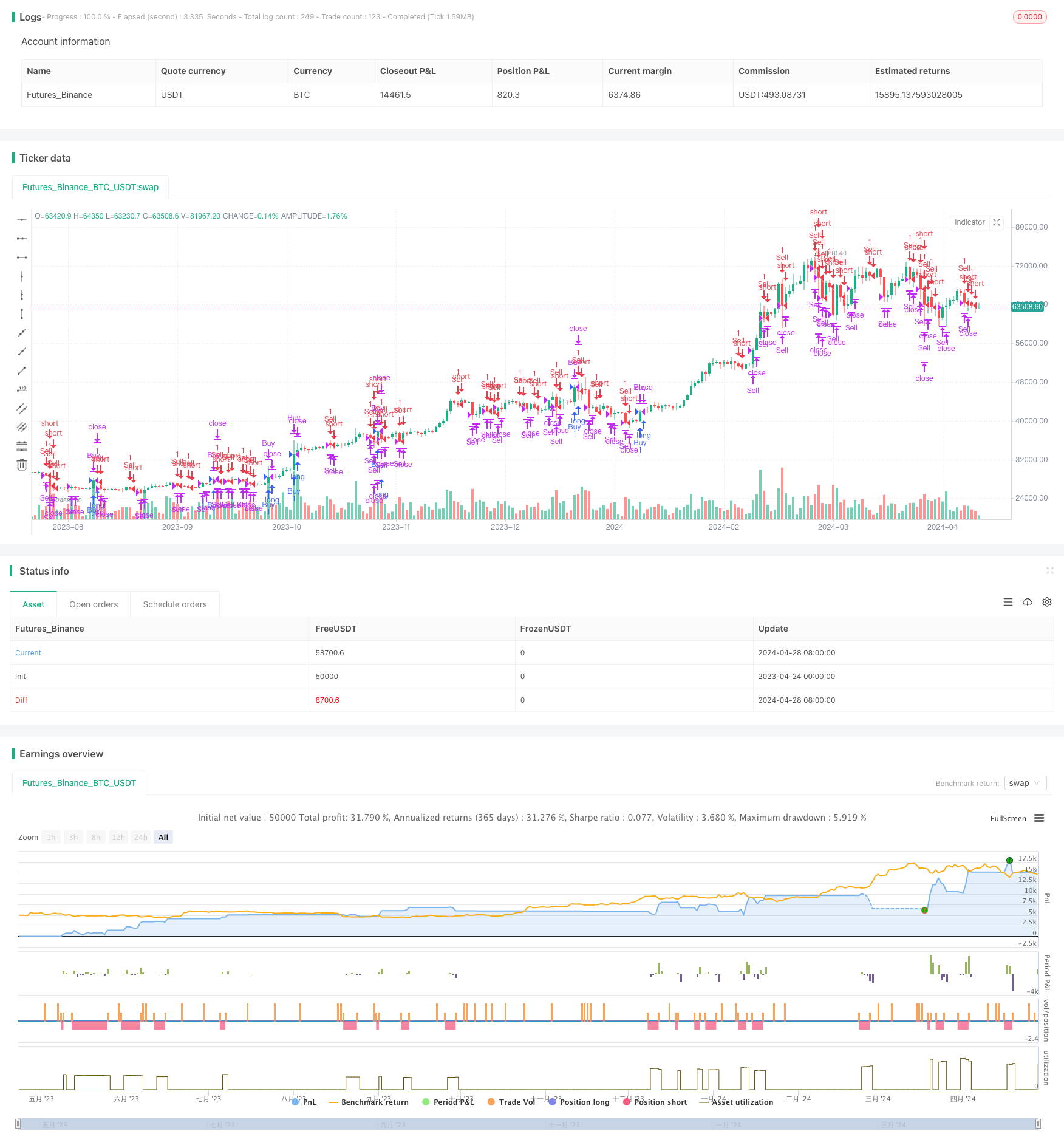
概述
RSI变动方向改变策略是一个基于相对强弱指标(RSI)的交易策略。该策略通过监测RSI的变化来判断市场趋势的变化,并根据RSI的变化幅度和价格的反转幅度来执行买入、卖出和平仓操作。该策略主要用于商品期货交易,旨在捕捉市场趋势变化的机会,实现低风险、高收益的交易目标。
策略原理
该策略的核心是利用RSI指标来判断市场趋势的变化。具体来说,该策略通过以下步骤来实现交易:
- 计算RSI指标的值。
- 计算RSI指标的变化幅度,即当前RSI值与上一个RSI值之差。
- 如果RSI变化幅度大于等于预设的阈值(rsiChangeThreshold),则执行买入操作。
- 如果RSI变化幅度小于等于预设阈值的负值,或者价格反转幅度小于等于预设的价格反转阈值(priceReverseThreshold),则执行卖出操作。
- 如果RSI变化幅度的绝对值大于等于预设的平仓阈值(rsiExitThreshold),则执行平仓操作。
通过以上步骤,该策略可以在RSI指标出现显著变化时及时执行交易操作,从而捕捉市场趋势变化的机会。
策略优势
- 简单易懂:该策略基于RSI指标,指标简单,计算方法易懂,适合新手交易者使用。
- 趋势跟踪:通过监测RSI指标的变化,该策略可以及时捕捉市场趋势的变化,实现趋势跟踪交易。
- 风险控制:该策略设置了多个阈值参数,可以根据市场情况和个人风险偏好进行调整,实现风险控制。
- 适用性广:该策略主要用于商品期货交易,但也可以应用于其他金融市场,如股票、外汇等。
策略风险
- 参数优化风险:该策略涉及多个阈值参数,如果参数设置不当,可能会导致策略表现不佳。因此,需要根据市场情况和历史数据进行参数优化。
- 市场风险:该策略主要依赖于RSI指标,如果市场出现异常波动或者RSI指标失效,策略可能会出现较大亏损。因此,需要结合其他技术指标和基本面分析来判断市场趋势。
- 过拟合风险:如果对策略参数进行过度优化,可能会导致策略在样本内表现良好,但在样本外表现不佳。因此,需要进行样本外测试和回测,验证策略的稳定性和可靠性。
策略优化方向
- 增加其他技术指标:可以考虑加入其他技术指标,如MACD、布林带等,以提高策略的准确性和可靠性。
- 优化参数:可以通过遗传算法、网格搜索等方法对策略参数进行优化,找到最优参数组合。
- 加入风险管理模块:可以考虑加入止损、止盈、仓位管理等风险管理模块,以控制策略的风险敞口。
- 适应不同市场:可以考虑针对不同市场和不同交易品种,设置不同的参数和交易规则,提高策略的适应性。
总结
RSI变动方向改变策略是一个简单易懂、适用性广的交易策略。通过监测RSI指标的变化,该策略可以捕捉市场趋势变化的机会,实现趋势跟踪交易。同时,该策略也存在一定的风险,如参数优化风险、市场风险和过拟合风险等。为了进一步提高策略的表现,可以考虑增加其他技术指标、优化参数、加入风险管理模块和适应不同市场等优化方向。总的来说,RSI变动方向改变策略是一个值得尝试和优化的交易策略。
策略源码
/*backtest
start: 2023-04-24 00:00:00
end: 2024-04-29 00:00:00
period: 1d
basePeriod: 1h
exchanges: [{"eid":"Futures_Binance","currency":"BTC_USDT"}]
*/
//@version=5
strategy("RSI Direction Change Strategy", shorttitle="RSI Direction Change", overlay=true)
// Input variables
rsiLength = input(14, title="RSI Length")
rsiChangeThreshold = input(10, title="RSI Change Threshold")
rsiExitThreshold = input(5, title="RSI Exit Threshold")
priceReverseThreshold = input(1, title="Price Reverse Threshold (%)")
// Calculate RSI
rsi = ta.rsi(close, rsiLength)
// Calculate RSI change
rsiChange = rsi - rsi[1]
// Buy condition: RSI change is greater than the threshold
buyCondition = rsiChange >= rsiChangeThreshold
// Sell condition: RSI change is less than the negative threshold or price reverses by 1 percent
sellCondition = rsiChange <= -rsiChangeThreshold or ((close - close[1]) / close[1] * 100) <= -priceReverseThreshold
// Exit condition: RSI change reverses direction by the exit threshold
exitCondition = (rsiChange >= 0 ? rsiChange : -rsiChange) >= rsiExitThreshold
// Execute buy order
strategy.entry("Buy", strategy.long, when=buyCondition)
// Execute sell order
strategy.entry("Sell", strategy.short, when=sellCondition)
// Execute exit order
strategy.close("Buy", when=exitCondition or sellCondition)
strategy.close("Sell", when=exitCondition or buyCondition)
相关推荐